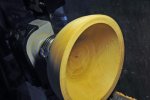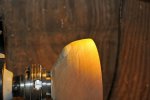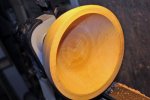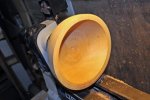Ned Bulken
Member
- Messages
- 5,529
- Location
- Lakeport NY and/or the nearest hotel
My friends Helen & Scott gave me another cherry log the other day, and Helen even cut it in half for me! Here's the first blank roughed out... about to go out and start the other half. Approximately 8-8.5" initially. I really need to work on my rounding cuts on the bandsaw, it was really unbalanced when I first spun it up.











